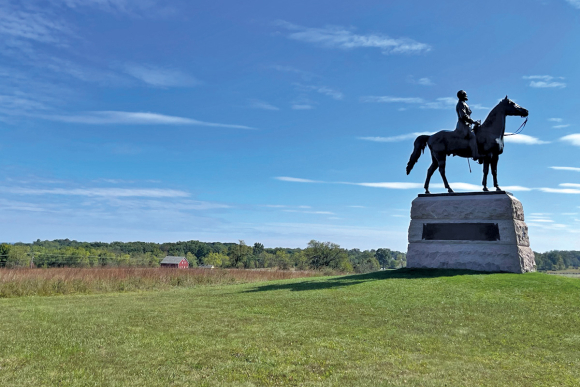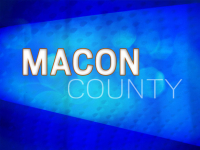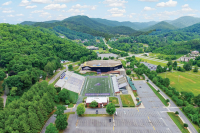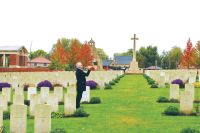This must be the place: ‘It is for us the living, rather, to be dedicated here to the unfinished work’

Somewhere around Schroon Lake, New York, just following a quick hike in the Adirondack Mountains, it was decided to head further down Interstate 87 to I-78, onward through Gettysburg, Pennsylvania, to get to Raleigh, North Carolina, for the International Bluegrass Music Association award show last Thursday.
The trek hovered around 12-14 hours depending on what route to take. The quickest way was along I-95, which is filled with endless traffic and relentless tolls. The long way was through Binghamton, New York, via I-88 and I-81. The middle route, much like Goldilocks and her desired porridge, was not too hot (expensive) or too cold (distance), so I-78 and U.S. 15 through Gettysburg.
Waking up in a Comfort Inn Suites in Bethlehem, Pennsylvania, it was a sunny early fall day in the Keystone State. Warm sunshine. Cool breeze. Crack the windows down slightly in the truck and breath in the fresh air. Following an extended family visit back up my native North Country, I still had to head to the IBMAs before finally landing back in my humble abode in Waynesville late Saturday.
With my girlfriend, Sarah, fading in and out of a road trip nap, I found myself doing what I usually do in those moments of vehicular solitude and silence — lost in thought. I kept thinking about the rollercoaster nature of family dynamics and whatever crisis was currently overtaking the conversation at the dinner table in my parents’ farmhouse before we left my hometown. Thoughts of the impending fall, haphazard visions of a long-gone summer in the rearview mirror.
Stopping to fuel up, I looked at the map on my smart phone. It appeared U.S. 15 goes right through the small town of Gettysburg. Site of one of the bloodiest and most important battles of the Civil War, the historic community was a place I’d only seen one time prior, when I was a junior in college at Quinnipiac University
I was a college athlete running track, specifically the 200-meter race, 400-meter and 4x400-meter relay. The conference championship meet was held at nearby Mount St. Mary’s University just below the Mason-Dixon Line in Maryland. Our team was housed at a Gettysburg hotel, shenanigans afoot as expected.
Related Items
And I only remember a handful of things from that jaunt those many years ago — we ate at an Italian restaurant in downtown Gettysburg, this old-school spot with heaping plates of homemade spaghetti; Long Island University showcases some of the fastest runners in the northeast, as seen by yours truly coming in last in the 400-meters; and our hotel was across the street from the battlefield, as I found out when I asked where it was located, the front desk guy pointing out the window into the darkness, saying in a monotone voice, “Right across the street.”
Skip ahead some 17 years and there I was, pulling up to the visitor’s center and museum on a Wednesday afternoon. Midweek and technically off-season until the foliage season emerges, the parking lot was still jammed packed. Mostly older folks, retired and crossing off another bucket list item on their travel wish list. Sarah and I stood out from the masses with our lack of grey hair and eagerness to walk the battlefield grounds instead of doing the one-way drive-thru loop.
I put on my running clothes and laced up my shoes. I wanted to take a steady jog along the roads meandering through the battlefield. Get out of the family car. Get off the tour bus. Disappear down the road and onto a backwoods horse trail, beads of sweat rolling down your face while thinking deeply, reflectively about exactly what transpired upon these sacred grounds almost 160 years ago.
Sarah wandered around the countless monuments dotting the battlefield, scoping out each one and reading the history, words, sentiments and names of those who fought bravely, thousands of which losing their lives in a ripple effect of political, economic and social fervor that still reverberates to this day in America.
While jogging along the road, I saw numerous bumper stickers bashing either Biden or Trump, t-shirts with similar sentiments on those hopping out of the vehicles to check out another monument. I thought of news heard on the radio earlier that day, divisive stories about Trump, Biden, presidential debates, a possible government shutdown, turmoil in the House of Representatives, high interest rates, an uncertain economy and ongoing political strife and concerns overseas in Russia, China and North Korea.
Soon, I found myself alone on the road. Gazing across the battlefield, it was silent and well-maintained. Rays of sunshine cascading down through the clouds and onto the grassy knolls, small creeks, dense tree lines and old stone walls. Silhouettes of dozens of monuments along the horizon behind me, endless fields in front of my position, ancient mountains in the distance.
Coming down a small knoll, I noticed an old farmhouse just a few hundred yards away. The sign in front of the quaint structure stated it was the Trostle House. According to history, “During the struggle for the Union’s left flank, Captain John Bigelow’s 9th Massachusetts Battery was ordered to hold their position at the Trostle Farm no matter the cost.”
The battery was greatly outnumbered by Confederate soldiers. Cannonballs and gunshots rang out in utter chaos. Hand-to-hand combat in the front yard. Bloodshed and murder in the name of one’s justified cause. There was still even a cannonball hole in the brick barn in the backyard, numerous horses killed by it.
Before I turned around and ran back to Sarah, back to the parking lot and back to the truck to continue on our journey to Raleigh, I took a few moments by myself to stand there at the Trostle Farm, staring respectfully and in awe of the cannonball hole in the wall, the lives lost on the property, the rest of the carnage all around the battlefield.
It was a moment of pure reflection, one of introspective inspiration and sheer gratitude towards the continued efforts by many in this country to not ever find ourselves in similar conflicts in our modern era. Nothing is the same, everything is the same, as they say, eh? Truth, my friend.
As an eternal optimist, I hold out hope for you, me and all of us — coming together for the sake of the greater good, for it’s the only way to move forward, come hell or high water.









